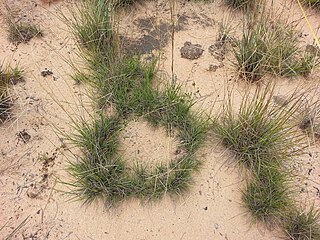
Dicoelia is a plant genus of the family Phyllanthaceae. It was first described as a genus in 1879. It is native to Borneo and Sumatra.
- Dicoelia beccarianaBenth. - Borneo
- Dicoelia sumatranaWelzen - Sumatra

Pogonophora is a plant genus of the family Peraceae first described as a genus in 1854. It is native to central Africa and northern South America.
- Pogonophora letouzeyiFeuillet, 1993 - Gabon, Congo
- Pogonophora schomburgkianaMiers ex Benth., 1854 - Colombia, Venezuela, Guyana, Suriname, Fr Guinea, N + E Brazil

Erythrococca is a plant genus of the family Euphorbiaceae, first described in 1849. It is native to Africa and the Arabian Peninsula.
Mareya is a plant genus of the family Euphorbiaceae, first described as a genus in 1860. It is native to tropical western and central Africa.
Pycnocoma is a genus of plant of the family Euphorbiaceae first described as a genus in 1849. It is native to tropical Africa and Madagascar.

Crotonogyne is a shrub of the spurge family (Euphorbiaceae) first described as a genus in 1864. It is native to western and central Africa. It is dioecious.
Dichostemma is a flowering plant genus in the family Euphorbiaceae first described as a genus in 1896. It is native to tropical western and central Africa.
- Dichostemma glaucescensPierre - Nigeria, Cameroon, Gabon, Republic of the Congo, Central African Republic, Cabinda, Democratic Republic of the Congo
- Dichostemma zenkeriPax - Cameroon
Oldfieldia is a plant genus under the family Picrodendraceae, the only member of its subtribe (Paiveusinae). It was described as a genus in 1850.
Protomegabaria is a genus of flowering plant belonging to the family Phyllanthaceae first described as a genus in 1911. It is native to western and central Africa. It is dioecious, with male and female flowers on separate plants.
- Protomegabaria macrophylla(Pax) Hutch. - Nigeria, Cameroon, Republic of the Congo, Gabon, Gulf of Guinea Islands
- Protomegabaria meiocarpaJ.Léonard - Gabon, Democratic Republic of the Congo
- Protomegabaria stapfiana(Beille) Hutch. - West Africa

Cleistanthus is a plant genus of the family Phyllanthaceae, tribe Bridelieae, first described as a genus in 1848. It is widespread in much of the Old World Tropics in Asia, Africa, Australia, and various oceanic islands. Cleistanthus collinus is known for being toxic and may be the agent of homicides or suicides.
Keayodendron is a genus of plants in the family Phyllanthaceae first described as a genus in 1959. It contains only one known species, Keayodendron bridelioides, native to tropical western and Central Africa. It is dioecious, with male and female flowers on separate plants.
Belonophora is a genus of flowering plants in the family Rubiaceae. It is found in Tropical Africa from Senegal east to Sudan and south to Angola. It was described by Joseph Dalton Hooker in 1873.
Cleistachne is a genus of African and Asian plants in the grass family. The only known species is Cleistachne sorghoides, native to Eastern Africa and Southeastern Africa, and parts of Asia.

Craspedorhachis is a genus of African plants in the grass family.
Leptaulus is a genus of trees and shrubs in the family Cardiopteridaceae described as a genus in 1862. It is native to tropical Africa including Madagascar.
Heterachne is a genus of Australian plants in the grass family.
Beilschmiedia gaboonensis is an evergreen tree in the subgenus Hufelandia of the genus Beilschmiedia, in the family Lauraceae. It is native to central Africa. It is a medium-sized tree which can measure up to 30 m tall with a bole diameter of up to 60 cm. It is distributed from southern Nigeria to the Congo Basin, occurring in Cameroon, Gabon and Zaïre. It is associated with marshy locations in lowland rainforest. Similarly to Beilschmiedia mannii, it is known under the trade names "kanda" and "pink kanda". The bark is used in analgesic and healing ointments.

Craterispermum is a genus of flowering plants in the family Rubiaceae. It contains 16 species that occur in tropical Africa and Seychelles. It is the only genus in the tribe Craterispermeae, of which the divergence time is estimated at 34.8 million years ago.

Pleiocarpa is a genus of plant in the family Apocynaceae first described as a genus in 1876. It is native to tropical Africa from Senegal to Tanzania and south to Zimbabwe. As of August 2013 the World Checklist of Selected Plant Families recognises 6 species:
- Pleiocarpa bicarpellataStapf - Cabinda, Cameroon, Republic of the Congo, Gabon, Democratic Republic of the Congo, Kenya
- Pleiocarpa brevistylaOmino - Gabon
- Pleiocarpa muticaBenth. - Ghana, Ivory Coast, Liberia, Sierra Leone, Nigeria, Cameroon, Gabon, Central African Republic, Republic of the Congo
- Pleiocarpa picralimoides(Pichon) Omino - Cabinda, Republic of the Congo, Gabon
- Pleiocarpa pycnantha(K.Schum) Stapf - widespread across most of tropical Africa
- Pleiocarpa rostrataBenth. - Nigeria, Cameroon, Gabon
- Pleiocarpa camerunensis(K.Schum. ex Hallier f.) Stapf = Hunteria camerunensisK.Schum. ex Hallier f.
- Pleiocarpa hockiiDe Wild. - Acokanthera oppositifolia(Lam.) Codd
- Pleiocarpa simii(Stapf) Stapf ex Hutch. & Dalziel = Hunteria simii(Stapf) H.Huber
Petersianthus is a genus of woody plant in the Lecythidaceae family first described as a genus in 1865 under the name Petersia. This turned out to be an illegitimate homonym, meaning that it had already been used by someone else to refer to a very different plant. So the name of these species in the Lecythidaceae was changed to Petersianthus. It is native to the Philippines and to parts of Africa. The following two species belong to this genus, with the basionyms of both taxa belonging to what is known today as the family Combretaceae.
- Petersianthus macrocarpus(P.Beauv.) Liben - Guinea, Ivory Coast, Cameroon, Congo Republic, Democratic Republic of the Congo, Cabinda, Gabon, Angola
- Petersianthus quadrialatus(Merr.) Merr. - Philippines








